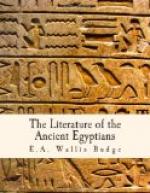day sky. The two vestibules were places of gloom
and semi-darkness, and the ten divisions of the Tuat
were covered by black night. When the Sun-god
set in the west in the evening he was obliged to travel
through the Tuat to the eastern sky, in order to rise
again on this earth on the following day. He
entered the Tuat at or near Thebes, proceeded northwards,
through the under-worlds of Thebes, Abydos, Herakleopolis,
Memphis, and Sais, then turned towards the east and
crossed the Delta, and, having passed through the
underworld of Heliopolis, appeared in the eastern sky
to resume his daily course from east to west.
His journey so far as Memphis he made in a boat, which
sailed on the river of the Tuat. At Memphis he
left the boat on the river, and entered a magical boat
formed of a serpent’s body, and so passed under
the mountainous district round about Sakkarah.
At or near Sais he returned to his river boat, and
sailing over the great marine lakes of the Delta reached
Heliopolis. The sun-god was guided through each
section of the Tuat by a goddess who belonged to the
district, and for the sake of uniformity the journey
through each section was supposed to occupy an hour;
the guiding goddess left the god’s boat at the
end of her hour, and the goddess of the next section
took her place. The path of the god was lighted
by fire, which the beings who lived in the various
sections poured out of their mouths, and the attendant
gods who were with them in his boat spake words of
power, which overcame all opposition and removed every
obstacle. As he passed through each section it
was temporarily lighted up by the fire already mentioned,
and he uttered words of power, the effect of which
was to supply the inhabitants of the section with
air, food, and drink, sufficient to last until the
next night, when he would renew the supply. Many
parts of the Tuat were filled with hideous monsters
in human and animal forms, and with evil spirits of
every kind, but they were all rendered powerless by
the spells uttered by the gods who were in attendance
on the Sun-god in his boat. At one time in the
history of Egypt it became the earnest wish of every
pious man to make the journey from this world to the
next in the Boat of the Sun. Armed with words
of power and amulets of all kinds, and relying on
their lives of moral rectitude, and the effect of
the offerings which they had made to the dead, their
souls entered the Boat, and set out on their journey.
When they reached Abydos their credentials were examined,
and those who were found to be speakers of the truth
and upright in their actions were allowed to continue
their journey with the Sun-god, and to live with him
ever after. Some souls preferred to remain at
Abydos and to live with Osiris, and those who were
found righteous in the Judgment were allowed to do
so, and were granted estates in perpetuity in the kingdom
of this god. The Book “AM TUAT” describes
the sections of the Tuat and their inhabitants, and
supplies all the information which the soul was supposed
to require in passing from this world to the next.
Many copies of certain sections of it are known, and
some of these are in the British Museum;[1] the most
complete copy of it is in the tomb of Seti I at Thebes.




